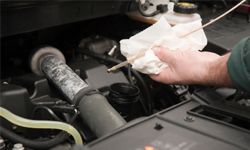If your arteries ever became clogged with gunk -- as does happen from time-to-time with us humans -- you and your doctor would want to take instant, massive action to fix the situation.
Similarly, if your car were ever to develop lots of oil deposits, you'd be well-advised to take immediate action as well. In both cases, the "heart" of the entire works -- your actual heart in your own body and the engine in your car -- would be in danger of seizing and suffering long-lasting harm.
Advertisement
We know that a sloppy diet and too little exercise cause sticky deposits called cholesterol to block our arteries. But what's the culprit behind oil gumming up our engine -- isn't oil one of the good guys when it comes to car engine health?
Well, yes, it is. But when oil is subjected to a high enough temperature, it can solidify and become baked onto the surface of whatever is close by, like for instance, a narrow engine oil passageway or critical engine parts themselves. It can also lose its viscosity and become a tar-like goop that makes life hard for your vehicle's engine.
When enough of these deposits collect, the possibility of a vehicle engine underperforming or even dying, go up dramatically. Thick or solid oil can have the reverse effect that clean, normal oil has. Instead of cleaning, lubricating and cooling your engine, it can pollute, hinder and contribute to overheating.
This article lists five of the most common clues that your vehicle is harboring oil deposits. Notice them too late and you could be facing a steep repair bill. But catch them early enough, and you could save yourself an engine and many greenbacks, not to mention peace of mind.



